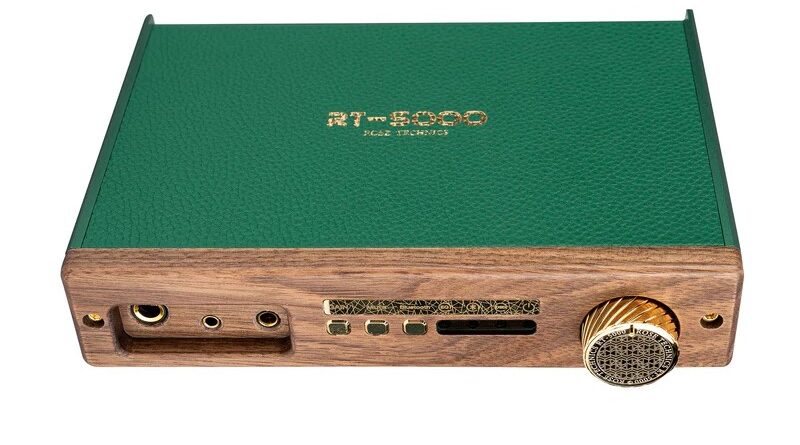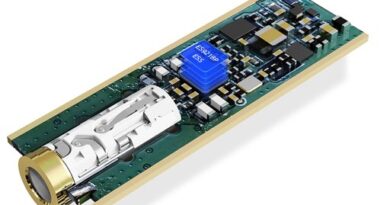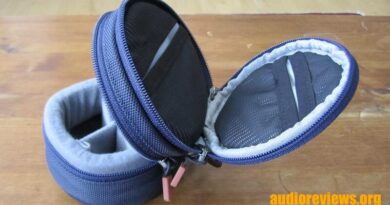Rose Technics RT-5000 Review – Surprising In A Few Senses
While I have to admit that I was initially mislead by the company name – I wrongly thought these were the same Korea-based guys producing some high quality earbuds I reviewed a few years go – I have been progressively intrigued by the dialogue established with Chengdu (PRC) based Rose Technics after they sent me a few of their higher end products to assess.
Their RT-5000 compact-size desktop DAC-AMP is the first device I completed my process on and I must anticipate I did find it overall good, with some element of surprise here and there requiring investigation, as I’ll try to clarify in the following chapters.
While the other devices they sent me (IEMs and cables) came directly from their factory, this RT-5000 unit was instead drop-shipped care of their distributor HifiGo. You can find official product specs and literature here, and you can buy an RT-5000 from HifiGo here.
In this Article
At-a-glance Card
| PROs | CONs |
| Solid, pleasing sound timbre | Some UI/UX quirks / oddities |
| Nice musical tonality | Lacking ROON support on Windows |
| Good reconstruction technicalities (layering, stage) | Lacking direct DSD support on Linux (ALSA) |
| Good power delivery (balanced output) | 110V power supply + external converter |
| Four selectable gain settings | Uninspiring single-ended output quality |
| Seven selectable FIR filters | High and Super Gain add hearable compression |
| Wide input options range | |
| Good value |
Features and description
Externals
The RT-5000 is a quite small unit in the category of desktop DAC/AMPs. Compact size is surelly helped also by the power supply being an external unit: it’s just 19,1 x 14,5 x 4 cm by circa 800gr of weight.
Stunningly, the power supply that came with my RT-5000 is a 110V unit (!). Together with it a commercial grade 220V-110V converter was also delivered. I do hope this is happening just for review units like the one I got, and regular EU retail packages are delivered with a 220V native PS.
The cabinet chassis is metallic, with ventilation grids on both side faces. Top and bottom plates are covered in faux leather, and the front bezel is made of solid wood offering a nice look. Don’t get me wrong, no word-class industrial design guru was surely engaged, yet the effort of conceding something to the eye is worth noting.
On the back panel we find the power cable connector and the power switch, digital data input connectors (USB, optical and coax), and analog Line Out connectors (single ended RCA and balanced XLR).
There is also an SMA connector, accepting an external BT antenna, and a physical switch nezt to it, which is supposed to commute digital input between USB mode and BT/COAX/OPT mode.
With RT-5000 a non-directional BT antenna tool is also supplied: it has the shape of a short black cylinder, and it is supposed of course to be installed (screwed) onto the aforementioned connector. Too bad that the cylinder is too large, and once installed it makes operating the digital input mode switch very difficult. A 100% avoidable design overlook.
On the front panel there are the 3 Phone Out jack connectors (single ended 6.35 and 3.5mm, and balanced 4.4mm) on the left, the volume knob on the far right, 3 control buttons and 3 led indicators on the center, and a small sticker plate above them carrying labels describing what’s below.
The volume knob presents a bad “scratchy” feeling while I turn it. I pulled it off and operated the volume pot’s axle by itself, and found it perfectly fluid. This helped me spot where the issue was: the knob’s bottom edge is not smoothed/filed out after production, and it frictionates against the not perfecfly flat wooden front bezel.
The label bar above the buttons and the LED lights is almost unreadable, both because letters are printed tone over tone so there’s too little contrast, and because of some supposed stylish overmarkings running all along the bar itself. Aforementioned style efforts apart, the product does not seem to exhude finishing accuracy.
Internals
No particular information regarding the internals of the PS unit is available. Sadly, I do not have any other PS units delivering 15V 3A on the secondary to try and swap to experimentally check whether they would improve vs the bundled on (which – unfairly judging just from the outside – seem pretty ordinary to say the least).
English translation on RT-5000’s spec sheet and dedicated web page are “approximate” to say the least, so to better investigate about the internals I opted to use two old tools: my eyes. I opened the cabinet and took a direct watch.
DAC is implemented via 2 x ESS9038Pro, say the docs, and those are indeed there. 9038Pro is a high end model in ESS lineup, also adopted by other direct competing Chifi manufacturers.
DAC chips are contoured by 10 x Texas OPA1612 chips, 8 dedicated to I/V conversion and 2 for low pass filtering. Again: very good chip choice, offering good results out of the box.
There is no standalone XMOS chip taking care of USB which is the reason why native ESS9028Pro’s capabilities are sadly cut down on RT-5000: 384Khz PCM and DSD256 are the devices’ max USB figures, down from of the 768Khz and DSD1024 chip’s own tops.
Up for some positive surprise now: 2 x Muses01 J-FET input op-amps!
Those are indeed an uncommon choice, and they surely contribute to setting RT-5000’s voicing on a page on its own (more on this below). They are also socket-mounted by the way, so they may easily be rolled by more experimenting-keen users.
Another not so common choice: the phone out stage is discrete, based on 2 x B772 and 2 x D882 transistors per channel, very visible on the PCB.
RT-5000’s marketing literature talks about “8 power tubes”. There are obviously no tubes inside RT-5000. I forgot the name of the chap who published an article I read some time ago, praising RT-5000’s tubes voicing, while noting how the unit’s heat up was very modest for his experience with tube amps… Transeat. After talking the finding through with kind Rose Technics people it turns out it’s a case of totally wrong translation: they meant to refer to the eight transistors I mentioned just above.
The QCC5125 BT chip is also visible, so is the AKM AK4118AEQ chip in charge of SPDIF communication.
In terms of “measurements figures” RT-5000 declares 125dB SNR, -115dB channel separation, and up to 800mW power on 32ohm loads from the single ended output, twice as much from the balanced out.
Input
In terms of signal input RT-5000 only accepts digital stuff, no analog inbound signal is supported. The unit can’t be used as a pure AMP.
Digital streams can be fed in via USB cable, optical cable, coax cable, or wirelessly via Bluetooth. As previously mentioned, there is a sort of master switch to enable either USB, or BT/Opt/Coax input.
Wireless input supports BT 5.1, and all fundamental codecs thereof: SBC, AAC, LDAC, AptxLL, Aptx Adaptive, Aptx HD. Maximum supported BT transfer speed is 990Kbps
USB input supports up to DSD 256 and PCM 32bit / 384KHz.
If hosting the device on a windows machine the native ASIO driver (downloadable from the manufacturer website of course) is strictly required to get DSD256 native support. WASAPI only would support DOP transfer, not native transfer, and up to DSD128 max.
En passant: Roon on Windows has problems with the current ASIO driver version. 32bit PCM suport requires to manually set 32bit as preferred resolution in the Bravo-HD (that’s the ASIO driver’s name) control panel. And worse: I could not have DSD native compatibility work at all, on Windows or on Linux. That’s bad, and something Rose Technics developers should look into.
User Interface
RT-5000 allows for the user to customise quite a few settings and that’s very positive.
On the flip side, both button operations and LED light indicators lack clarity, hergonomics, and even logic.
Single-clicking on the leftmost button (labelled Gain) you can set… the Gain, indeed.
RT-5000 allows for even 4 (four!) different gain modes (Low, Medium, High and Super) which is very interesting as it gives the system a very wide applicative range, from super sensitive IEMs up to hard to drive overears.
The bad news is that the device does not inform the user about the currently set Gain level. No leds, no other ways. There is also no visual feedback when someone actually presses the button to switch Gain levels.
Quite primitively, the user may then only “try pushing” the button while listening to some music, and by doing that a few times [s]he will “learn” (or “remember”) what Gain level was set, and set it where [s]he wants it now… only to forget what such setting one second later, unless (literally) [s]he writes it down on a post-it stuck near or onto the device.
Long-pressing (3+ seconds) the same Gain button you can instead select the preferred FIR filter.
RT-5000 makes the full set of 7 (seven) filters offered by its ESS9028Pro DAC chips available to the user:
- Linear phase fast roll off
- Linear phase slow roll off
- Minimum phase fast roll off
- Minimum phase slow roll off
- Apodizing fast roll off
- Hybrid fast roll off
- Brick wall
For some culture about what FIR filters are and hints on how to choose the most appropriate one for your taste and for the particular tracks you are listeing to, you may want to refer to this other article of mine.
Sadly, the situation in terms of user experience in regards of filter setting is almost as bad as that regarding Gain level. Once again, there is no visual information about which of those filters is set at any given time.
When the Gain button is long-pressed the leftmost LED (labelled…. “EQ”????) will flash white for a number of times corresponding to the ordinal number of the filter, as per above list.
So for example if by long-pressing the button the LED flashes 5 times, that means the filter has now been set to (5) Apodizing fast roll off, and this way we also “discover” that the previous setting was (4) Minimum phase roll off.
How about remembering such setting “tomorrow”? I’d recommend using the same post-it already carrying the Gain setting information…
The second button from the left is the Mute button. Click it once to disable sound output. Again, there is no visual evidence of its status, no LED showing whether Mute is on or not. So if RT-5000 does not output any sound, well… try randomly pressing some buttons!
The third (rightmost) button manages BT operations. And guess what: it does it in a not more user friendly way compared to Gain, Filters or Mute.
Regardless of the position of the USB vs BT/OPT/COAX switch on the back panel, long pressing the Bluetooth front button puts RT-5000 in BT pairing mode. When such mode is ON, the second LED light in the series, labelled with the BT logo, will start pulsing BLUE relatively fast. At this point one can look for RT-5000 onto a BT source (say: a phone, or a dap) and pair them. The BT LED will start blinking slower once pairing happens.
Once some source is paired it’s time to look at the USB vs BT/OPT/COAX back panel switch. Setting it into the BT/OPT/COAX position will disable USB input, and enable the other options.
And finally: going back to the front panel and single-pressing the third button (the same that was long-pressed to enable pairing) will toggle BT ON (and disable OPT/COAX) or toggle BT OFF (and enable OPT/COAX).
The third LED, labelled DSD, is to inform you about the presence of DSD data on the USB input line. It will stay off when PCM data is received (on any channel). It will turn on solid GREEN when DSD is received (via USB only of course, as it is the sole DSD supporting channel).
Lastly, the fourth LED is the “ON” signal. It lights up when RT-5000 is turned on. Fair enough. But why was the RED colour chosen to indicate ON status? Ah, well…
If I am the sole one finding this design of button presses and LED lightings anti-hergonomic please tell me straight.
Output
RT-5000 has a total of 5 output ports.
On the front panel there are the phone-outs – 6.35mm and 3.5mm jacks for single ended, and 4.4mm for balanced lines respectively – for headphone connectivity.
On the back panel there are the corresponding Line Outs – an RCA pair for single ended, and an XLR pair for balanced – for connecting to a standalone amp, or powered speakers.
Other features
MQA Rendering
RT-5000 is a “MQA Renderer”, so it can fully unfold MQA tracks on its own hardware, which is an upgrade vs the default represented by having the music player host do the unfolding, and only limited to the first 2 folds.
The value of such feature – or RT5000 and any other MQA-capable device – now that Tidal [finally] dropped MQA is all to be discovered.
ASIO Driver
I already mentioned this en-passant: exploiting RT-5000’s full resolution capabilities (up to 384KHz PCM or up to DSD256 native) on a USB-connected Windows host requires the installation of a particular ASIO driver, which is freely downloadable from Rose Technics site.
Sadly, the driver is not fully compliant with Roon, so until an appropriate update is release Roon users (like me) are recommended to opt for the exclusive Wasapi option, which means 192KHz PCM cap on one end, and DOP DSD128 max on the other. Not a huge limitation for most consumer users, sill something to get rid of if Rose wants to better qualify for the most exacting customers.
Sound and power
Let me start from the bottom for once: RT-5000 sounds very well, I have been impressed.
The DAC responds a reconstructs very well, with a good or even very good level of detail, space reconstruction, layering and separation.
The amp section is also very good. Powerful, more than reasonably clean, and what I feel is its most distinctive chracater is that totally personal full-body note timbre which you can bet is 100% consequence of the J-FET amp choice and is subsequent discrete amping stage. Such timbre is to me putting RT-5000 a bit on a side within the budget (< 1K$) desktop DAC-AMP market, in the good sense of course.
Oh by the way: much like most if not all similar devices on this catagory, RT5000 should be used from its balanced output only. Single ended output is significatly less clean, and delivers a less dynamical sound. Just leave that alone – use Balanced output, period.
The 4-step Gain setup is a very good feature.
I suspect Low gain to even carry a negative value, for how dampened the output is when selecting that. Fact is: RT-5000 supports oversensitive loads (Andromeda) with no hint of an hiss on Low gain and that’s certainly positively surprising for an otherwise quite muscular desktop device.
Medium Gain (i.e. Gain step 2) is no doubt the daily way to go. On it RT5000 delivers all the Balanced output power it takes to make all of my primary drivers sing properly, with commendable cleanness and good microdynamics.
High Gain starts delivering some range compression. On Super Gain range compression becomes quite evident, making it a viable compromise only for super-heavy loads. RT-5000 drives HD800 with no particular problem on Medium Gain anyway, and – on the opposite impedance end – even E5000 get a good treat on Medium Gain.
If I have to look for points of possible improvement on the sound category I would point to the power supply: RT-5000 would surely deserve an upgrade option – be it a separately available item, to avoid increasing the base price tag.
Specifications (as declared by the manufacturer)
- ES9038Pro Dual DAC Setup
- Qualcomm QCC5125 Bluetooth Chipset
- Texas Instruments OPA1612 OPAMPs.
- Double JRC MUSES 01 J-FET Oxygen-Free Copper Frame OPAMPs.
- Four-Level Gain Modes.
- Output Power Up to 1600mW@32Ω
- SNR 125dB
- Channel separation -115dB
- Artistic Solid-Wood and Leather Build
- Headphone Output Options : 3.5mm + 4.4mm + 6.35mm
- Input Options : Coaxial + USB + Optical
- Line-Output Options: RCA + XLR
- Dimensions: 191×144.5x40mm.
- Weight: 822.5 grams.
Conclusions
Comprehensively speaking, RT-5000 is a good product. Its features, and most of all the quality of its analog reconstruction and amplification deeds far surpass the few usability oddities, and the various sw rough edges, in primis fine tuning USB connectivity and reaching full support status with ROON, none of which seems a huge hurdle to me, it’s all stuff the manufacturer can smooth out in the short term.
Our generic standard disclaimer.







